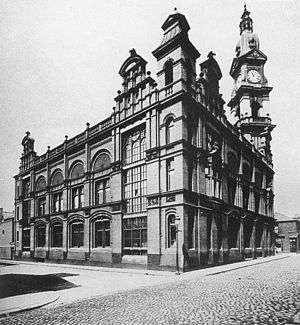Beecham Group
 | |
| Industry | Pharmaceuticals |
|---|---|
| Fate | Merged with SmithKline Beckman |
| Successor | SmithKline Beecham (now GlaxoSmithKline) |
| Founded | 1859 |
| Defunct | 1989 |
| Headquarters | London, United Kingdom |
| Products | Phenethicillin, Methicillin |
The Beecham Group plc was a British pharmaceutical company. It was once a constituent of the FTSE 100 Index. Beecham, after having merged with SmithKline Beckman to become SmithKline Beecham, merged with Glaxo Wellcome to become GlaxoSmithKline (GSK). GSK still uses the Beechams brand name in the UK for its over-the-counter cold and flu relief products.[1]
History

Beecham began as the family business of Thomas Beecham (1820–1907), a chemist. (Beecham would become the grandfather of music conductor Thomas Beecham, 1879–1961). As a boy, Beecham worked as a shepherd, selling herbal remedies as a sideline.
He later became a travelling salesman or peddler full time. His first product was Beecham's Pills, a laxative, in 1842.[2] Subsequent success enabled him to open a shop in Wigan in 1847.[3] Beecham opened its first factory in 1849 in St Helens, Lancashire, for the rapid production of medicines.[2] Under his son, Sir Joseph Beecham, 1st Baronet (1848–1916), the business expanded, but remained a patent medicine company and engaged in little research.
In 1924 Philip Hill, who made his money in real estate, acquired control of Beecham.[4] Under his leadership, the company bought up other companies for their various products and for their marketing infrastructure, acquiring the Lucozade glucose drink and Macleans (toothpaste) in 1938 and, at the same time, introducing the Ribena blackcurrant drink.[5] In 1938 it also bought the company selling Eno which had an extensive international presence.[4][6]:253 By purchasing the company manufacturing Brylcreem the following year, the company added hair products for men to its offerings.[2]
In 1943, Beecham decided to focus more on improving research and built Beecham Research Laboratories from Brockham Park, Surrey. In 1945, the company was re-named Beecham Group Ltd.[2] in 1953 Beecham acquired C.L. Bencard, which specialised in allergy vaccines.[2]
In 1959, Brockham Park became famous when Beecham scientists there discovered the penicillin nucleus, 6-APA (6-aminopenicillanic acid);[7] This discovery allowed Beecham, working in tandem with Bristol-Myers, to synthesize of a number of new semisynthetic penicillins. Beecham marketed Broxil (phenethicillin), followed shortly by the more potent Celbenin (methicillin), which was active against Staphylococcus aureus. The group continued to focus on pharmaceutical development, producing further semi-synthetic penicillins. However, when Penbritin (ampicillin) came on the market in 1961, Beecham's facilities were soon inadequate for the worldwide demand the drug generated. A 35-acre (140,000 m2) complex at Worthing came on line in the early 1960s to produce phenethicillin, followed by the ability to produce 6-APA, the base for semisynthetic penicillins.
The company continued to add products, and acquire other companies through the 1970s and 1980s. In 1971 the S. E. Massengill Company was acquired. Beecham launched Amoxil (amoxicillin), in 1972, which went on to become one of the most widely prescribed antibiotics.[2] In 1973, Aqua-fresh toothpaste was launched, and in 1977, the Sucrets brand was acquired. Augmentin, an antibiotic used to treat an array of bacterial infections, was introduced in 1981.[2] The Aqua Velva and Geritol brands were acquired from J. B. Williams in 1982.
In 1986, the Beecham Group sold its numerous soft drink brands including Tango, Top Deck, Corona, Quosh, as well as the UK franchises for Pepsi and 7 Up, to Britvic.[8] The same year, Beecham acquired Norcliff Thayer from Revlon.
As the turn of the century approached, more significant mergers began to occur. In 1989, The Beecham Group plc and SmithKline Beckman merged to form SmithKline Beecham plc.[2][9] In 2000, SmithKline Beecham and GlaxoWellcome merged to form GlaxoSmithKline.[10]
A history of the company, Beechams, 1848–2000: From Pills to Pharmaceuticals, written by Thomas Anthony Buchanan Corley, was published in 2011.
Products
Consumer healthcare
- Aqua-fresh
- Beecham's Pills
- Beecham's Powders[11]
- Brylcreem
- Eno
- Horlicks
- Lucozade
- Ribena
- Macleans
Pharmaceuticals
- Amoxil (amoxicillin)
- Augmentin (co-amoxiclav)
- Avandia (rosiglitazone)
- Bactroban (mupirocin)
- Broxil (pheneticillin)
- Celbenin (meticillin)
- clavulanic acid
- Eminase (anistreplase)
- Engerix-B (hepatitis B vaccine)
- Floxapen (flucloxacillin)
- granisetron
- Havrix (hepatitis A vaccine)
- Orbenin (cloxacillin)
- Paxil (paroxetine)
- Penbritin (ampicillin)
- Pollinex (extract of ragweed pollen)
- Pyopen (carbenicillin)
- Relifex (nabumetone)
- Temopen (temocillin)
- Ticarpen (ticarcillin)
- Timentin (ticarcillin/clavulanate)
See also
References
- ↑ "Get powerful relief from cold & flu symptoms with Beechams". beechams.co.uk. Retrieved 7 May 2012.
- 1 2 3 4 5 6 7 8 "Our history - GSK". Retrieved 19 November 2016.
- ↑ Thomas Beecham at Oxford Dictionary of National Biography
- 1 2 Tedlow, Richard S.; Jones, Geoffrey G. (2014). The Rise and Fall of Mass Marketing (RLE Marketing) Volume 25 of Routledge Library Editions: Marketing. Routledge. pp. 110–111. ISBN 9781317663010.
- ↑ "SmithKline Beecham: History" Archived 20 July 2013 at the Wayback Machine., History of Advertising Trust
- ↑ Wilkins, Mira (2004). The history of foreign investment in the United States, 1914-1945. Cambridge, Massachusetts: Harvard University Press. ISBN 9780674045187.
- ↑ Batchelor, F.R.; Doyle, F. P.; Naylor, J. H. C.; Rolinson, G. N. "Synthesis of Penicillin: 6-Aminopenicillanic Acid in Penicillin Fermentations" (PDF). Nature.
- ↑ Carbonated drinks: a report on the supply by manufacturers of carbonated drinks in the United Kingdom, Chapter 8 para 8.51
- ↑ "Profile: SmithKline Beecham". BBC. 18 December 2000.
- ↑ "The Glaxo SmithKline merger". BBC News. 17 January 2000.
- ↑ "Beechams Powders - Summary of Product Characteristics (SPC) - (eMC)". Retrieved 19 November 2016.